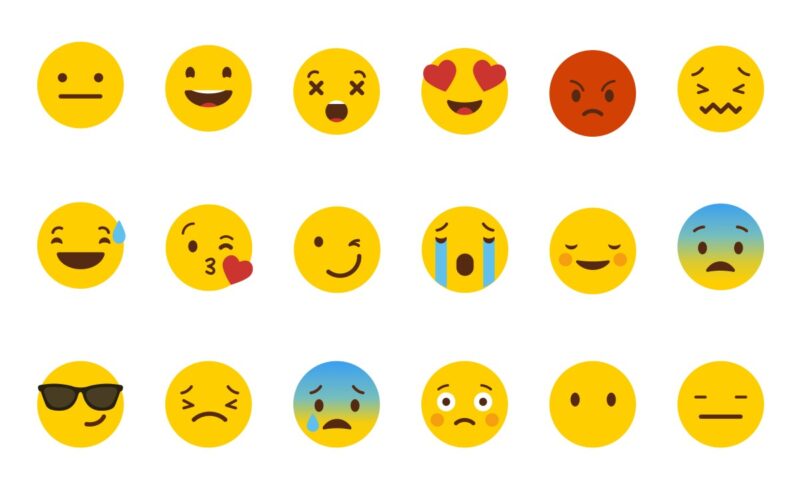Body language and tone of voice do not come through in text messages and emails, so other ways of conveying nuance have been developed. Notable among these were the additions of two new hieroglyphs: emoticons and emojis. Emoticons and emojis are commonly used by many people around the world. They have become an essential part of electronic communication. An emoticon or emoji is used to convey a human expression. It can be inserted from the menu of visual representations or created using a sequence of symbols on the keyboard. Emoticons and emojis help express the feelings of the writer or emailer and give better context to his or her writing.
The emoticon was born out of a joke that occurred at Carnegie Mellon University in 1982. A “mercury spill” gag posted on an online message board threw the university into confusion. Because of this confusion, Dr. Scott E. Fahlman suggested that jokes and non-jokes be marked with two sets of letters: smiley face “:-)” and frown “:-(,” which is now recognized as the standard emoticon. After this, emoticons became very popular among Internet users. Many applications now have a menu of emoticons that can be inserted automatically (Bellis, 2019).
Emojis were invented by Shigeru Kurita in 1999, but it was not until 1997 that the Japanese conglomerate Softbank introduced its first pictogram. The emojis developed by Kurita for Japanese users were very simple: 12 pixels by 12 pixels. They were based on manga and kanji characters (Grannan, 2019).
Difference between emoticons and emojis
Emoticons are pictograms consisting of punctuation, numbers, and letters that generally express emotion and sentiment, and the name emoticon is derived from the emotional icon. Due to keyboard limitations, most pictograms must be read horizontally.
Emojis (e “pictures” or “characters” + moji “letters” in Japanese) are a somewhat new invention. Emojis are pictures of faces, objects, and symbols and should not be confused with their predecessors. It is well known that Apple emojis have a distinctive style, including cartoon-like faces with various expressions, families, buildings, animals, food, and mathematical symbols.
An emoticon is a smiley face with characters that look like those on a computer keyboard. An emoji is something that looks like a small cartoon that is free of the constraints of punctuation, numbers, and letters (Grannan, 2019).
Types of emoticons and emoji — what they mean
| Meaning | Emoticon | Emoji |
| Happy / smile | “:)” | 😊 |
| Wink | “;)” | 😉 |
| Tease or sticking your tongue out | “:P” | 😋 |
| Surprised or a gasp | “:O” | 😯 |
| Unhappy | “:(“ | 😒 |
| Really sad or crying | “:'(“ | 😞 😢 😭 |
| Big smile | “:D” | 😃😆 |
| Flat expression for I feel nothing | “:|” | 😐 |
| Keep one’s mouth shut | “:X” | 🤐 |
| Extra good and happy | “O:)” | 😇 |
Table1: Who Invented Emoticons and Emoji?(Bellis, 2019), What Does This Emoji Mean? Emoji Face Meanings Explained(Bates, 2019)
Improve our communication
Currently, six billion emoticons or emojis are sent every day, and 74% of people in the U.S. regularly use emoticons and emojis in their online communications, with an average of 96 emoticons or emojis sent per day. This growth in popularity has a lot to do with the fact that people’s communication is becoming increasingly digital.
Emoticons and emojis represent a shift in communication for both individuals and businesses. Today’s generation uses emoticons, emojis, and GIFs on a daily basis, and they have a significant impact on how we communicate on the Internet and in text messages. In fact, despite not being a word, the Oxford Dictionary has named emojis the word of 2015, demonstrating the power of this small image. They address the issue of being unable to communicate emotions and gestures by expressing them through a variety of illustrated characters. Furthermore, they aid in the display of facial expressions, human gestures, and tone of voice in digital communication, facilitating and enriching it.
Emojis and emoticons have become firmly entrenched in digital communication as a result of the development of social media and smartphones. Some people dismiss the use of emojis as frivolous, but there is no doubt that they have improved the nuance and richness of our digital communications (Hamza, 2022).
Reference
Bates, P. (2019). What Does This Emoji Mean? Emoji Face Meanings Explained. [online] MUO. Available at: https://www.makeuseof.com/tag/emoji-english-dictionary-emoji-faces-meaning-explained/ [Accessed 28 February 2023].
Bellis, M. (2019). Who Invented Emoticons and Emoji? [online] ThoughtCo. Available at: https://www.thoughtco.com/emoticons-and-emoji-1991412#:~:text=%22Emojis%20were%20first%20invented%20by%20Shigetaka%20Kurita%20in [Accessed 22 February 2023].
Grannan, C. (2019). What’s the Difference Between Emoji and Emoticons? | Britannica. In: Encyclopædia Britannica. [online] Available at: https://www.britannica.com/story/whats-the-difference-between-emoji-and-emoticons [Accessed 27 February 2023].
hamza (2022). How Have Emojis Transformed the Ways We Communicate? [online] Medium. Available at: https://bootcamp.uxdesign.cc/how-have-emojis-transformed-the-ways-we-communicate-d559336dec54 [Accessed 28 February 2023].
